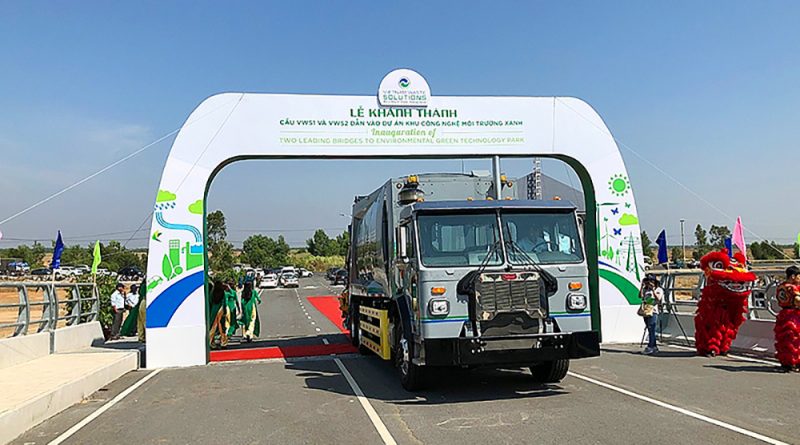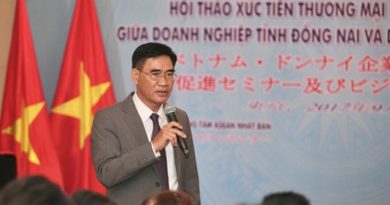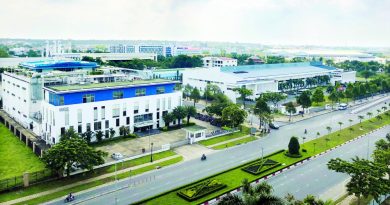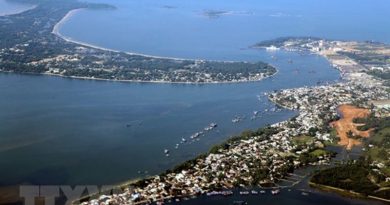VWS commits to greener Vietnam
Vietnam Waste Solutions (VWS) inaugurated two bridges and an approach road to Green Environmental Technology Park in the Mekong Delta province of Long An. David Duong, president and CEO of California Waste Solutions and Vietnam Waste Solutions, shared with VIR’s Minh Hang the business plans of the two companies.

David Duong.
What is the significance of the inauguration of these two bridges and the approach road to Green Environmental Technology Park?
Vietnam Waste Solutions (VWS) has just inaugurated two bridges and an approach road leading to the Green Environmental Technology Park in Tan Lap commune, Thu Thua district of the Mekong Delta province of Long An. The bridges are named VWS01 and VWS02, while the road has a design load of HL93.
The length of the entire route is 200 metres, including the side roads to the bridges. The 75m wide bridge has six lanes that are 3.5m wide each. The three lanes on each side are separated by a 5m wide median strip. There are two pavements which are about 10m wide and a safety corridor which is about 13.5m wide.
The project has been launched after one year of construction, which proves VWS’s efforts and determination to increase investment and put the project into operation as soon as possible. To facilitate the goal, the company has mobilised significant financial, technology, and human resources.
What is the role of Green Environmental Technology Park in Long An?
Green Environmental Technology Park in Long An was approved by the prime minister in Decision No.1440/QD-TTg dated October 6, 2008. This is one of the most modern waste treatment facilities, not only in Asia, but across the globe.
Covering an area of 1,760 hectares, the park will be developed in three phases. The first phase, which will last until 2025, will treat an estimated 21,400 tonnes of waste per day.
Meanwhile, in the second phase (from 2026 to 2035) and the third phase (until 2050), the park will handle 26,800 and 40,000 tonnes each day, respectively. A total of $450 million will be poured into the first phase of the project.
The total capacity is adequate to meet the waste treatment demand of the southern key economic zone. At present, eight localities in the area discharge more than 10,000 tonnes of waste per day, 7,000 tonnes of which comes from Ho Chi Minh City.
It is projected that more than 20,000 tonnes of waste will be produced a day in the park by 2020, with 9,000 tonnes coming from Ho Chi Minh City alone. Meanwhile, industrial waste is on the rise and will catch up and may even move ahead of household waste.
What are the most outstanding features of the project, and what new technologies will you apply for waste treatment?
The project applies cutting-edge technologies that not only comply with Vietnam’s Law on Environmental Protection, but also meet the most stringent US standards. Once in operation, the project will process different types of waste, including household waste, hazardous waste, medical waste, industrial waste, electronic waste, sewage, and old tyres.
Most of the waste recycled will be converted into energy as well as produce compost fertilisers, liquid fuel, and fuel gas. The project will minimise burial rate below 9 per cent in order to conserve land resources and protect the environment.
According to the prime minister’s decision, the project will be capable of handling 40,000 tonnes of waste per day with a lifespan of 75-100 years. Thus, Green Environmental Technology Park will play a vital role in waste treatment for the southern key economic zone.
When waste treatment activities are concentrated on a single site, investors can mobilise large resources to invest in state-of-the-art technologies, which results in lower fees for pollution treatment. Meanwhile, it is easier to use large garbage trucks to collect garbage around the park.
As a result, there will be fewer trucks running around the area, reducing unpleasant odours in the streets. It is also convenient for the regulatory bodies to monitor garbage collection and waste treatment activities in the park.
The contract between CWS and San Jose city is set to expire in 2021. Do you have any difficulties in extending the contract for another 15 years?
Indeed, we are facing some obstacles in the negotiation of the new contract. Under the contract, we are running a programme of garbage collection. Accordingly, each household can dispose of three unwanted items free of charge every year, such as a bed, a wardrobe, or a fridge. They can call us in advance so the company can prepare vehicles and workers to collect the items, especially those of a large nature.
However, in recent times, there has been information handed out wrongly, saying that households can discharge any number of large items and call the company anytime to collect them. The company could not prepare enough vehicles, collectors, and phone operators for this onslaught. As a result, our services failed to meet customer expectations.
Furthermore, residents were also told that they do not need to classify waste by its source believing they should place all garbage together in order to reduce costs.
As a result, many households do not classify their waste, making it harder for us to collect. We had to increase fees for collection, equal to the fee of unclassified waste made by other companies. The city decided to re-bid the project because of concerns with our services and fees.
In addition, we also face difficulties in transferring from the garbage bin to the truck, with issues in ensuring lids remain shut after the bin is returned to its original location. Other firms have also struggled with the same problems for the past 12 years. However, in recent times only our company has been fined for it.
What solutions have you prepared to tackle these problems?
We have put forward some very convincing arguments to the San Jose City Council against the evaluations made by the San Jose Environmental Services Department.
Specifically, the company collects recycled waste from 166,000 households, amounting to 80 per cent of all households in San Jose city. Over the past 12 years, our services have never been caught out for poor service.
Meanwhile, our fees are not higher than other companies. We have continued our efforts to bring the best services to the residents. The company is pledging support from the state protection agency for ethnic minorities as well as the Vietnamese community, which account for 11 per cent of San Jose’s population.
As a result, the San Jose City Council has requested the San Jose Environmental Services Department open negotiations about our services and fees. We accept to be inspected for one year for different issues such as letting customers call anytime, closing the lids of the garbage bins, as well as reducing the garbage collection fee for each household. Our fees are lower than other companies by $1, totalling $2 million per year.
What is your preparation for the upcoming inspection?
VWS will be inspected for one year. To ensure transparency, we have requested the city to hire a third-party inspection company. The fees for garbage collection this year will be higher than in the old contract, but they will match the new fees in the 15-year contract.
As we are an ethnic company, it is quite hard to win such a contract, not to mention keeping it. It will take time and a great deal of effort to prove our capability.
As a Vietnamese American, how do you feel about the successful development of of Da Phuoc Integrated Waste Management Facility and Green Environmental Technology Park?
The successful investment in Vietnam has significant meaning not only to me, but also to much of the Vietnamese overseas community. It shows that Vietnamese people all over the world can produce significant achievements when they return to invest in their homeland.
Phan Van Toi – Vice Chairman, Thu Thua District People’s Committee
Long An province, including Thu Thua district, is facing huge pressure from waste treatment with 500-600 tonnes of waste in need of treatment every day. The province fails to classify waste from its source, while waste treatment activities are scattered around the locality. Therefore, the Long An People’s Committee has worked with Vietnam-Long An Waste Solutions to develop a waste incineration plant with a capacity of 1,000 tonnes per day at Green Environmental Technology Park.
Covering five hectares, the park is slated to begin operation later this year, with a daily module capacity of 250 tonnes. This is a positive signal for waste treatment works in Thu Thua district in paticular, and for Long An in general. We encourage investors to accelerate the development of the project and complete any of the infrastructure required, in order to bring the project into operation soon.
Source: vir.com.vn







